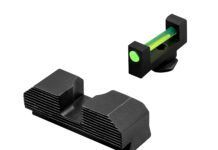When shopping for a rifle scope it is common to find a variety divided by purpose. Hunting scopes and tactical scopes are two popular categories. But should they really be listed so far apart? Just as the AR-15 platform continues to evolve as a hunting rifle, why shouldnt military-style optical scopes do the same? Tactical scopes are bred to provide an advantage over multiple targets at short to moderate distance, or an adversary at long range. For the hunter, this could translate to scenarios such as engaging rabbits in between their start and stop behavior or an elk standing far in the distance. Typically, the difference between tactical scopes is the reticle pattern and degree of magnification, depending on the application they were designed for. In this test we will favor the long-distance shooter and evaluate three Mil-Dot rifle scopes with variable power that tops out at 20X or above. They are the $1400 6-24X50mm Burris Xtreme Tactical Rifle scope No. 201934, the $999 6-21X50mm Bushnell Elite No. 42-6245T, and Trijicons $1275 TR23-2G 5-20X50mm AccuPoint scope.
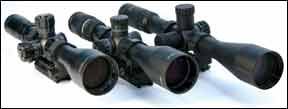
Each scope was built on a 30mm-diameter tube with a 50mm objective lens and a reticle wherein the vertical and horizontal crosshairs were strung with evenly spaced dots (Mil-Dots). All three scopes showed reticles in the first focal plane, and the knobs offered .25-MOA click adjustment. We chose this format because the reticle pattern can actually be used to “range” the target at any level of magnification using the following equation:
Height or width of target in yards multiplied by 1000; divided by the apparent size of the target as measured against the Mil-Dot reticle, equaled distance.
As you can see, you must know the approximate size of the target. When military or police snipers deal with the human torso, the measurement they typically use is 30 inches, or 0.833 yards. Game hunters merely need to insert the average height of the target area according to the animal they wish to engage, say from the bottom of the rib cage to the shoulder. The Mil-Dot reticle comes into play when you look through the scope and determine how tall the target appears when measured against the reticle. For example, if when placing the center of the crosshairs at the bottom of the target area the upper edge of the target sits midway between the second and third Mil-Dots, the lower part of the equation would be 2.5. Once distance is determined, elevation can be adjusted according to published data, such as a range card or “true statements” of elevation adjustment that the shooter has established through actual tests. In addition to its ranging ability, the Mil-Dot reticle offers another advantage over common crosshairs. Holding over for added elevation or holding off to fight wind drift becomes much easier with the additional visual aid of the Mil-Dots. This makes visualizing a hold that changes both windage and elevation much easier. Imagine the necessity to hold low and to the right. The shooter can then line up the shot first shifting the point of aim from the center of the crosshairs to the first Miil-Dot to the right of center. Then the point of aim can be dropped by lowering the rifle directly downward until the new horizontal point of reference is the first mil dot above the center of the crosshairs. If this point of aim proves not to be perfect, at least it will provide a substantial frame of reference for the next shot. Holding off center by say one Mil-Dot can also be effective when engaging a moving target. Indeed, the presence of the dots can also make it easier to visualize holding off by one-half the distance between Mil-Dots, and so on.
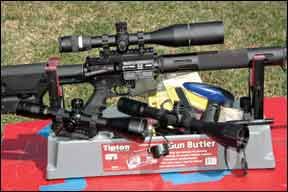
Our comparison of the three scopes is accompanied by a chart showing basic information such as size, weight, etc. Weve also added a line for how many clicks were available from the windage and elevation knobs. This is important to know so that before transferring the same scope from one rifle to another, the scope can be returned to its mechanical center. By mechanical center we mean that if there are 300 clicks available from each knob, 150 clicks from full right or its lowest possible adjustment should put the reticle comfortably centered within the scope. Some calibers demand a lot of upward adjustment for really long range shooting. For example, the 308 Winchester (topped with a 175-grain bullet) typically asks for a 600-yard elevation adjustment of 14.75 MOA, or 59 clicks. But a 1000-yard shot would require approximately 36.75 MOA, or 147 clicks, and it is at the edges of the lens that vision will suffer from parallax, the apparent displacement or the difference in apparent direction of an object as seen from two different points not on a straight line with the object. We used a gentle grip when turning the knobs. Sensitivity to the clicks is a must.
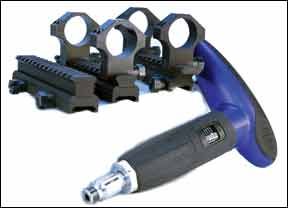
Testing scopes can however be limited in terms of hard facts. No two people see exactly alike, so whatever ratings may apply to the amount of light or quality of light transmitted to the shooters eyes could in the end be subjective. One of the visual aids we used was a $15 lifesize Coyote target from Caldwell that featured detailed vitals and replaceable overlays (No. 800345). Set afield at a distance of 100 yards, we peered through each scope and compared how well we could pick out the reticle against the realistic montage of coyote fur. Immediately next to the Coyote target was a typical range target for comparison. All three scopes allowed us to shoot sub-MOA groups at the heart, lung, and base of the neck bone on the Caldwell target. We wrapped up our tests with a hike over private land that allowed us to focus on (but not shoot at) a variety of distances and back drops.
Aside from the subjective viewing, we did the best we could to judge how well each scope performed as they were designed to. For example, the calibration of the Mil-Dots had to be consistent and offer predictability. After zeroing each scope, we held off 2 Mil-Dots to the right and to the left, firing five shot groups for each hold. Were all four groups the same distance from center? We referred to this as our hold-off test. We tried to minimize shooter error and effects of the environment (wind and light), by performing these tests from 50 yards. Our mechanical tests were performed with the scopes at maximum magnification.
We called our next test the crank test because we cranked the windage elevation 4 MOA (16 clicks) right and left and fired 5-shot
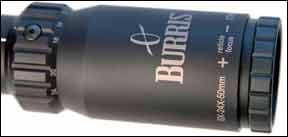
groups. We repeated this exercise with the elevation knob first down then up. We chose to move downward first because, in our experience, some scope springs have more difficulty recovering from compression than from expansion. Again, we fired five-shot groups. Was each group printed equidistant from our original point of aim? Were they level and on line with the central group? Did returning the adjustment knobs back to center realign the reticle so that hits were centered at our original point of aim?
Each scope was pre-mounted using rings and bases available from Brownells. That way, the scopes could be quickly interchanged from atop the Picatinny rail as a solid unit.
Our test ammunition for the 50-yard shots was the Sellier & Bellot 55-grain FMJ ammunition. For our longer-distance testing, we relied upon a handload featuring 69-grain Sierra bullets over Varget powder, proven to deliver sub-MOA groups from our test rifle. In terms of durability from shock or recoil, we realize that firing 223 Remington was not a harsh challenge. But we werent about to use the scopes as hammers, either. Each scope was backed by a lifetime warranty, and in our view only the longest period of testing will determine the durability of these products.
Burris XTR 624 6-24X50mm
Xtreme Tactical Riflescope, $1400
The Burris XTR was the longest of our three scopes. This could be an advantage or a disadvantage, depending on the way it is mounted. In some instances a long-bodied scope that reaches further back over the stock can be very helpful. The XTR also came with aluminum screw-on covers for the adjustment knobs. Integrated with the adjustment knobs, by the way, was an Allen wrench held inside the elevation tower. If you are doing a lot of
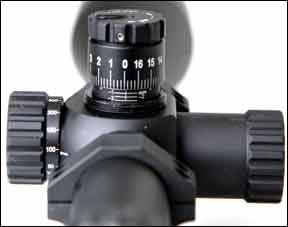
adjustments on the fly, then there is always the risk of losing the covers. But it is also a great way to protect the knobs from dirt and moisture and incidental contact during transport that can knock them out of adjustment.
To protect the lenses, the XTR shipped with plug-like covers connected by a rubber strap. The strap attached to covers by press fitting into a groove on the outside of each cover. They were prone to falling off the strap. Wed replace them. The XTRs reticle varied slightly from the Mil-Dot format by providing lines instead of dots on the lower half of the vertical crosshair. Our staff thought this was an advantage if you had the information to accurately match your ammunition to a specific distance for each line. Each one of our scopes showed crosshairs that emanated from a heavy black line at the border of the lens. But we preferred the way the heavy black lines of the XTR tapered to an arrow, bringing our eyes to the crosshairs more quickly.
We found the calibration for the adjustment knobs to be clearly marked and easily visible from behind the scope. But which direction to rotate the knobs was imprinted only on the top surfaces and therefore not visible to the shooter from behind the stock. Rotation was counter-clockwise for up and also counter-clockwise for right marked 0-16 MOA. We counted 292 total clicks of adjustment making 146 clicks from bottom to mechanical zero. But it took another 50 clicks to align the bottom of the adjustment knob with the zero-line on the adjustment tower. This was most adjustment available from our three scopes, offering the most cushion for elevation adjustment for long-range shots. The windage ring offered 100 clicks of adjustment, which is way more
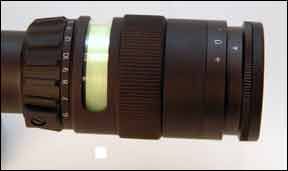
than wed ever use. Unfortunately, the windage ring on our XTR was free to rotate due to a loose roll pin.
In our holdover test, the groups landed about 3.9 inches to either side. At twice the distance (100 yards), we could estimate that a two Mil-Dot hold off would account for a displacement of about 7.8 inches. Compared to the clinical value of a Mil-Dot-about 3.6 inches-thats not bad for a real-world test including shooter error.
Cranking the windage knobs 16 clicks showed that right-side movement resulted in a group 2.2 inches from center. Left-side movement put the group 2.2 inches from center. Return to zero was perfect. In our elevation test, the challenge was for the scope mechanism to overcome compression and raise the point of impact the same distance above center as we had just lowered it. Sixteen clicks downward delivered a group measuring about 2.4 inches below our point of aim. Raising the elevation knob 32 clicks from this position (8 MOA) delivered a group that was centered about 2.2 inches above dead center. When the scope was returned to original zero, groups hit about 1.8 inches low, indicating that the elevation adjustment was less resilient than it should be.
Our Team Said: The greatest strength of the Burris XTR scope was its reticle. Despite breaking from the Mil-Dot pattern along the bottom half of the vertical crosshair the lines were bold, sharp and blocked the least amount of target when compared to our other scopes. We liked the side focus better than the others, and its clear marking meant that, once determined, we could quickly dial in the proper distance and arrive at a usable focus. Downside: Whenever we began by scanning at a lower magnification, we found it cumbersome to have to rotate the entire eyepiece in order to zero-in on our target.
Trijicon AccuPoint TR23-2G 5-20X50mm, $1275
The Trijicon AccuPoint separates itself from the pack by presenting a green dot at dead center of the reticle. Wrapped around the eyepiece just behind the heavily grooved rubber-coated magnification ring was a separate ring with handy grip lines. Cut into this ring was a window covering a little less than 180 degrees
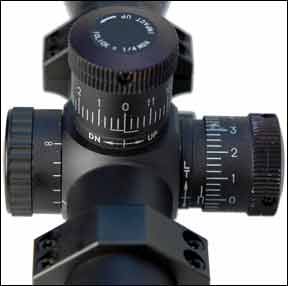
of the tube. Behind the window was a light-gathering filament measuring about 0.30 inches wide. Moving this ring regulated intensity by determining how much light was getting to the filament, which powered a tritium-phosphor lamp. The result was a 0.5-MOA illuminated green dot at the center of the reticle. (An amber-colored dot is also available). For the purpose of this article we will continue to refer to the illumination as a dot, but it was actually cube-shaped, which helped maintain the reticle grid. With the filament window shuttered in daylight the reticle appeared to be a solid intersection of black crosshairs. This caused us to doubt that the illumination was in fact self-powered. According to Trijicon, we needed to let our eyes adjust to the darkness to see it glow without the help of ambient light feeding from the filament. Rising at 2 a.m. in a darkened house, we peered into the scope with the filament fully covered and saw that the dot was visible. The owner doesnt have to worry about battery life.
The dot best responded to ambient light. In dim overcast light, we found that a pinhole of light was available at the center of the reticle. Aside from the illumination feature, our staff was impressed with the overall clarity of the AccuPoint scope. There was also more space between mildots, giving the shooter a bright, seemingly wider field of view. But of our three scopes, both the lines and the dots were heavier and blocked out more target area.
The use of illumination in the Trijicon line of scopes was designed to introduce the Bindon Aiming Concept (BAC) to the shooter. According to the www.Trijicon.com website, “The BAC allows the shooter to track and engage targets faster.” As we understand the explanation, an illuminated dot allows the shooter to find targets more quickly with both eyes open. “As soon as the weapon begins to steady in the target area, the brain switches to the magnified view along with the aiming point.” We think the illuminated dot in this case was more helpful in finding the center of our aim at dawn and dusk than in a fast-action situation.
The construction of the AccuPoint was certainly robust and confidence inspiring. Side focus was marked from 40 to infinity with regular hashmarks, but no other corresponding numbers. Rotation was very easy, with perhaps too little detent to hold the dial in place. This was suitable for the lone shooter who was merely looking for focus, but this would make following the instructions of a spotter more difficult. Fine focus was available by rotating the eyepiece. A section of the rear tube was grooved for grip, but so long as the scope was mounted, the magnification and eyepiece focus rings were easily turned without affecting the other. The Trijicon was the only scope delivered without some form of scope cover.
The windage and elevation dials were marked from 0 to 11, for 12 MOA per revolution. The clicks may not have been audible, but the ratchets were well defined. Directional arrows for both windage and elevation were clearly visible from behind the scope, as well
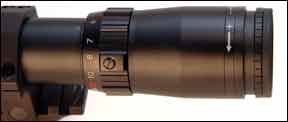
as from above and to the side. The lines on the elevation and windage towers were not numbered.
In our 2-dot holdoff test, the point of impact averaged about 3.9 inches from the center. This would be ideal, but the variation was as large as 3.8 inches to the left and 4.2 inches to the right. The center of each group was level with our zero group in the center. Our initial suspicion was that this was the result of wind conditions. Cranking the knobs 4 MOA in either direction for our windage test, we found about a one-half inch difference in placement of the point of impact. Average displacement was close to perfect (2.07 inches), but this time the left-side group was further away, 2.4 inches from center versus 1.8 inches to the right.
In terms of adjustment for elevation, a total of 206 clicks were available from top to bottom. Dead center was 103 clicks from the bottom or the top. (We counted 195 clicks of windage adjustment.) Sixteen clicks moved the point of impact about 2.9 inches below our point of aim. But 32 clicks upward from this point moved the point of impact only 1.8 inches above our point of aim.
Our Team Said: We liked the airy view and expansive grid presented by the reticle. The larger Mil-Dots made it easier to perform visual measurements, but the giveback was that they blocked more target area. Thanks to the illumination. most of our staff would choose the AccuPoint for work in early morning or dusk. Of our three scopes, we think this one offered the fastest target acquisition, but were not sure how the elevation mechanisms would stand up to a lifetime of being adjusted up and down. With a somewhat limited elevation adjustment, you may want to choose between dedicating this scope to mid-range targets or build in some elevation during the mounting procedure.
Bushnell Elite 4200 Tactical 6-21X50mm
No. 42-6245T, $999
Despite being listed as being the same length as the Trijicon scope, our Bushnell scope was shorter in length by about the width of the eyepiece adjustment ring. Actually, overall length was sort of negotiable due to there being a difference of about 0.4 inches of movement when the eyepiece ring was turned in or out. This was
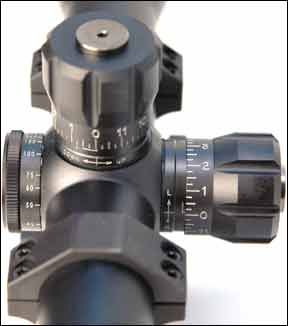
more than twice as much as our other scopes. Mixed with the side focus, which was a flat knob calibrated from 25 yards to 500 yards to infinity in decreasing lengths between hashmarks, this gave us a slightly wider range of focus. How helpful this was depended on the shooters own quality of vision. But we think it did help us in the field when focusing on our most distant target, a hut at 442 yards, especially when the light was muted by cloud cover.
The magnification ring was bold, easy to turn, and offered the largest numbers from 6 to 24. Above 8X, the number jumped by two and the number 12, half power, was red. The adjustment turret showed the mounted shooter which direction was up, down, right, and left, but the top of each adjustment knob was left blank. The knobs themselves were bulbous and grooved for grip. The numbers (0-11, for a total of 12 MOA) were large and clear. Turning the knobs offered well-defined clicks for each one-quarter MOA. The Elite was the only scope in our test that offered the same amount of adjustment for both windage and elevation (186 clicks). Traditional cup-like lens covers connected by elastic were supplied. The total of these features made the Bushnell Elite 4200 very easy to use.
In our hold-off test, we landed groups 4.0 inches to the left and 3.7 inches to the right. The variation in height was almost nil. To measure the differential between distances from point of aim in our windage knob test, we had to go two columns right of the decimal point. Sixteen clicks left moved point of impact 2.3 inches. Thirty-two clicks right pushed point of impact 2.2 inches right of our original zero. Returning the scope to our original zero was almost perfect, close enough to be blamed on shooter error.
As shown by our first two scopes, the most challenging aspect of our test was to move the point of impact up 4 MOA from our zero after having been lowered 4 MOA and have the resulting groups land equidistant from center. Both the Burris and Trijicon scopes failed to completely lift point of impact to the proper height. The Bushnell scope, however, was able to raise the point of impact 2.4 inches above zero after dropping it 2.4 inches downward. Given that each scope was shot under comparable conditions at the range, this was the best performance, our testers said.
Our Team Said: Head-to-head, we jumped back and forth trying to compare definition in changing sunlight. As close as they were, we think the Bushnell Elite may have somewhat better definition under overcast skies.
And in a majority vote, we think the reticle had the most edge. After calling out distances to our shooter, we think the side focus may also be the more accurate dial by doing a better job of matching clarity to calibration. The adjustment knobs had plenty of feedback and solid detent. With “only” 98 clicks of adjustment available in either direction, we might wish for more vertical space or choose to build in more elevation via the mount. But with an MSRP of less than $1000, we are sure you can pay more for several scopes that offer a lot less.




























